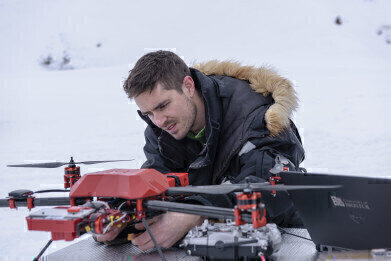-
 Dr Joseph Cook adjusting the quadcopter in the field in Svalbard (credit Marc Latzel /Rolex)
Dr Joseph Cook adjusting the quadcopter in the field in Svalbard (credit Marc Latzel /Rolex)
News
Microscopic Mapping Reveals Impact Data for Melting Ice-Sheets
Feb 28 2020
An international team of scientists including researchers from the Institute of Biological, Environmental and Rural Sciences (IBERS) at Aberystwyth University and an international team of scientists are monitoring microscopic organisms that live on glaciers and ice sheets in the Arctic to establish whether there is a relationship between the speed at which glaciers melt and the microscopic life prevalent on them.
Using Artificial Intelligence (AI) satellite imagery and drone technology Dr Joseph Cook at IBERS has been able to map the algae covering 200m x 200m areas of ice in Svalbard and Greenland and use the information to analyse satellite data over much larger regions.
The study(1) revealed that as much as 12.2 billion tonnes of ice melted as a consequence of these algae in the summer of 2016, in the south-western region of the ice sheet where these algae are most abundant.
This upper estimate represents 13% of the total ice lost from that region over the summer months.
Dr Cook said: “We have found that the dark coloured algae (dark brown/purple) absorb sunlight very effectively - in the same way that when we wear black clothes on a hot day, we feel hotter. Because algae cells contain a pigment that acts as a natural ‘sun-screen’ that absorbs sunlight and re-radiates the energy back out as heat, that heat causes ice to melt.
“These initial findings indicate that the more dark coloured algae we see on a glacier, the faster that glacier will melt and that on the Greenland Ice Sheet this is happening on an enormous scale.”
“By training an algorithm on our field data and validating it using drone imagery, we were able to classify the ice surface into categories and produce maps.We can now combine this with satellite imagery and, using cloud computing tools, scale it to much larger areas. The data generated shows us the amount of melting that can be attributed to the algae.”
The team’s discoveries will have a significant impact on the future of climate change research and management.
Dr Cook said: “This is an exciting finding, and it is really just the beginning – this work will open the door to a whole new field of research about algae’s contributions to ice melting rates, and therefore sea-level rise. Until now, it was not known that microbial life contributes to sea-level rise - but now we can start to build this in to future projections which will enable more accurate planning and management.
“Internationally, scientists and policy makers will now be able to make better informed decisions to help prepare for sea-level rise across the globe over the coming decades, and potentially even centuries.”
The research is being conducted with support from a Microsoft AI for Earth grant, which makes Microsoft cloud and AI tools available to those working to solve global environmental challenges, in close collaboration with the Natural Environment Research Council’s (NERC’s) Black and Bloom and MicroMelt projects.
(1)The Cryosphere, the journal of the European Geosciences Union.
Glacier algae accelerate melt rates on the south-western Greenland Ice Sheet
Pub:29 January 2020. Additional authors from Aberystwyth University on the study are Professor Alun Hubbard and Dr Tristram D. L. Irvine-Fynn, both of the University’s Department of Geography and Earth Sciences.
Digital Edition
Lab Asia Dec 2025
December 2025
Chromatography Articles- Cutting-edge sample preparation tools help laboratories to stay ahead of the curveMass Spectrometry & Spectroscopy Articles- Unlocking the complexity of metabolomics: Pushi...
View all digital editions
Events
Jan 21 2026 Tokyo, Japan
Jan 28 2026 Tokyo, Japan
Jan 29 2026 New Delhi, India
Feb 07 2026 Boston, MA, USA
Asia Pharma Expo/Asia Lab Expo
Feb 12 2026 Dhaka, Bangladesh


















